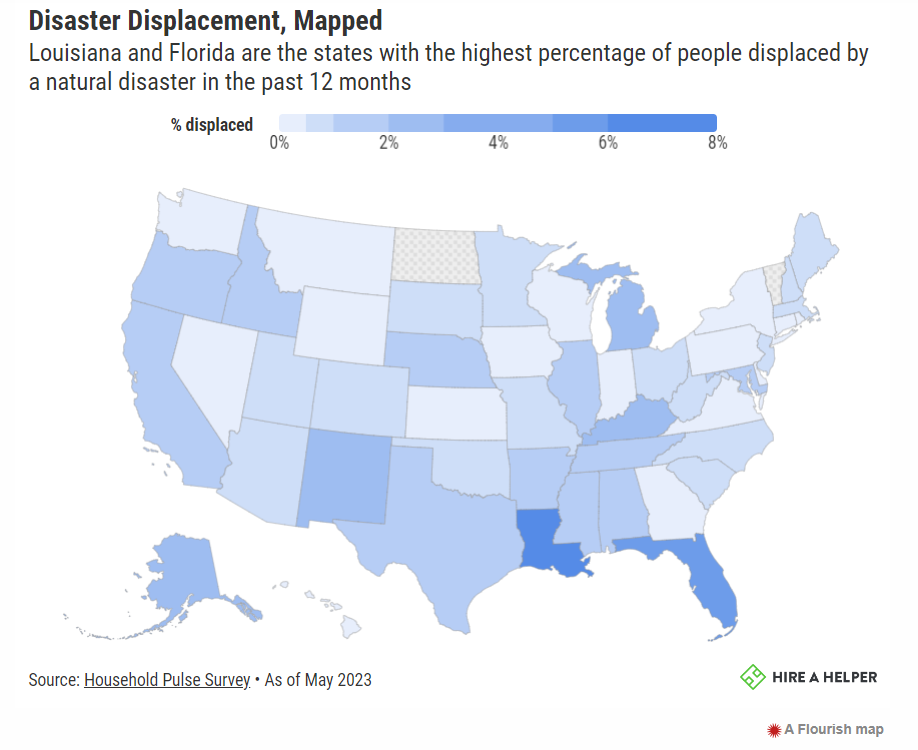 Approximately three million Americans were displaced from their homes in 2022 due to extreme weather events, and 18% of them, or 530,000 of those displaced, have not returned, according to a recently published study from HireAHelper.
Approximately three million Americans were displaced from their homes in 2022 due to extreme weather events, and 18% of them, or 530,000 of those displaced, have not returned, according to a recently published study from HireAHelper.
Based on data from the U.S. Census Household Pulse Survey and Current Population Survey covering a 12-month period, research analysts at the HireAHelper moving blog examined the overall numbers of natural disaster-forced moves, the displaced homeowners’ typical destinations, and what types of events are likely to force Americans from their homes.
About one-fourth of those who relocated due to a disaster—most commonly hurricanes and storms (51% in 2022)—moved to a new state. Fires were the disaster most likely to result in long-term or terminal displacement. Of those households displaced by fire, 45% never returned to their homes.
According to the analysts, “it’s worth noting that a majority of extreme weather-related relocations are temporary, with 33% of those Americans who have been forced to leave their home due to a natural disaster at some point in the past 12 months returning home within just a week.” Another 31% returned home within a month, and 19% within six months.

Louisiana, with 7.5% of its residents displaced at some point in the year, recorded the most disaster-forced relocations. Texas was the state to which most disaster-affected homeowners moved during the course of the study.
“Not only is Texas by far the most common destination for moves made by those fleeing a natural disaster, but it’s also the state with the highest number of disaster refugees relative to the local population (58 per 10,000),” the researchers said.
Though Louisiana has not endured a particular major disaster this year, it is likely the high numbers result from parts of the state still recovering from the damage caused by Hurricane Laura in 2020 and Hurricane Ida in 2021, according to the report.
The second most affected state is Florida, with 5.6% of its residents temporarily or permanently displaced, and which recently endured Hurricane Ian, reportedly one of the worst hurricanes in U.S. history. CoreLogic estimated that the damage and loss totals from Hurricane Ian—including total flood and wind losses—were between $41 billion and $70 billion. This total includes wind loss, re-evaluated insured and uninsured storm surge loss and newly calculated inland flood loss for residential and commercial properties.
The number of Americans who moved due to a natural disaster has yet to reach the level of Hurricane Katrina, which in 2005 forced one million people from their homes and claimed at least 1,000 lives.
“There have been some spikes of displacements of over 100,000 that have coincided with U.S. natural disasters, such as Hurricane Ike in 2008, Hurricane Florence in 2018, and the California Wildfires of 2019,” the report says.
After hurricanes and storms, wildfires accounted for 23% of displacements and 26% are attributed to floods in a one-year period. On a smaller scale, earthquakes, landslides, and volcanic activity also displaced homeowners either temporarily or permanently in 2022.
HireAHelper’s full report including regional data and analysis, illustrative graphs and charts, and methodology is available at blog.hireahelper.com.


 DSNews The homepage of the servicing industry
DSNews The homepage of the servicing industry









